Mapping Urban Heat Demand with the Use of GIS-Based Tools
Abstract
:1. Introduction
2. Materials and Methods
2.1. Tools
2.2. Required Inputs
2.3. Grid Characteristics
2.4. Description of Heat Demand Calculation Method
2.4.1. Main Equation
2.4.2. Heat Demand Coefficients
- post-war multi-family buildings: buildings usually built between 1945–1965 year in the traditional technology;
- residential blocks: apartment blocks technologies prefabricated usually built since the mid-60s.
2.5. Calculation of the Final Energy Consumption
2.6. Description of Heat Demand Forecasting Method
2.6.1. Short-Term Projections
2.6.2. Mid-Term Projections
3. Results and Discussion
3.1. Base Year Situation
3.2. Demand Projections
3.4. Validation of the Results
- (i)
- NMSE < 1.5
- (ii)
- FAC2 > 0.5.
4. Conclusions
Acknowledgments
Author Contributions
Conflicts of Interest
Nomenclature
| Af | total heated area of the building [m2] |
| Az | building area on the outer contour of the building [m2] |
| cf | heated area calibration ratio |
| d | annual demolishing rate of existing heated area [%] |
| eu | specific heat demand for energy service u in buildings per area [kWh/(m2⋅year)] |
| l | number of floors above ground level |
| Qu | useful heat demand for energy service u [kWh/year] |
| r | remaining building areas after modernization and demolishing [%] |
| y | number of years after the base year |
| annual thermo-modernization rate of the existing buildings area by classes [%] | |
| annual energy intensity improvement due to thermo-modernization [%] | |
| Superscript and Subscript | |
| b | building belonging to set B |
| cl | class of heat intensity within a building type belonging to set CL |
| k | grid cell belonging to set K |
| new | new construction after the base year 2015 |
| s | balance zone belonging to set S |
| t | building utility type belonging to set T |
| u | energy service including space heating (h), ventilation (ve) and domestic hot water preparation (w) |
References
- Wyrwa, A. An optimization platform for Poland’s power sector considering air pollution and health effects. Environ. Model. Softw. 2015, 74, 227–237. [Google Scholar] [CrossRef]
- Perera, D.W.U.; Winkler, D.; Skeie, N.-O. Multi-floor building heating models in MATLAB and Modelica environments. Appl. Energy 2016, 171, 46–57. [Google Scholar] [CrossRef]
- Evangelisti, L.; Guattari, C.; Gori, P. Energy retrofit strategies for residential building envelopes: An Italian case study of an early-50s building. Sustainability 2015, 7, 10445–10460. [Google Scholar] [CrossRef]
- Valdiserri, P.; Biserni, C.; Tosi, G.; Garai, M. Retrofit strategies applied to a tertiary building assisted by trnsys energy simulation tool. Energy Proced. 2015, 78, 765–770. [Google Scholar] [CrossRef]
- Valdiserri, P.; Biserni, C. Energy performance of an existing office building in the northern part of Italy: Retrofitting actions and economic assessment. Sustain. Cities Soc. 2016, 27, 65–72. [Google Scholar] [CrossRef]
- Gils, H.C.A. GIS-Based Assessment of the District Heating Potential in Europe; Deutsches Zentrum für Luft-und Raumfahrt (DLR): Graz, Austria, 2012. [Google Scholar]
- Persson, U.; Werner, S. Quantifying the heating and cooling demand in Europe. In STRATEGO Work Package 2; Halmstad University: Halmstad, Sweden, 2015. [Google Scholar]
- Bernd, M. Mapping the heating and cooling demand in Europe. In STRATEGO Work Package 2; University of Flensburg: Flensburg, Germany, 2015. [Google Scholar]
- Finney, K.N.; Sharifi, V.N.; Swithenbank, J.; Nolan, A.; White, S.; Ogden, S. Developments to an existing city-wide district energy network—Part I: Identification of potential expansions using heat mapping. Energy Convers. Manag. 2012, 62, 165–175. [Google Scholar] [CrossRef]
- IEE Project TABULA. Available online: http://episcope.eu/iee-project/tabula/ (accessed on 9 March 2017).
- Reiter, D.; Botzenhart, F.; Mühlich, P.; Hamacher, T.; Reuter, A. Developing a roadmap for the future energy infrastructure in Salzburg. In Proceedings of the 10th IAEE European Conference, Vienna, Austria, 7–10 September 2009. [Google Scholar]
- Törnros, T.; Resch, B.; Rupp, M.; Gündra, H. Geospatial analysis of the building heat demand and distribution losses in a district heating network. ISPRS Int. J. Geo-Inf. 2016, 5, 219. [Google Scholar] [CrossRef]
- Delmastro, C.; Mutani, G.; Schranz, L. The evaluation of buildings energy consumption and the optimization of district heating networks: A GIS-based model. Int. J. Energy Environ. Eng. 2016, 7, 343–351. [Google Scholar] [CrossRef]
- Mastrucci, A.; Baume, O.; Stazi, F.; Leopold, U. Estimating energy savings for the residential building stock of an entire city: A GIS-based statistical downscaling approach applied to Rotterdam. Energy Build. 2014, 75, 358–367. [Google Scholar] [CrossRef]
- Theodoridou, I.; Karteris, M.; Mallinis, G.; Papadopoulos, A.M.; Hegger, M. Assessment of retrofitting measures and solar systems’ potential in urban areas using geographical information systems: Application to a Mediterranean city. Renew. Sustain. Energy Rev. 2012, 16, 6239–6261. [Google Scholar] [CrossRef]
- Möller, B. A heat atlas for demand and supply management in Denmark. Manag. Environ. Qual. Int. J. 2008, 19, 467–479. [Google Scholar] [CrossRef]
- Petrovic, S.; Karlsson, K. Model for determining geographical distribution of heat saving potentials in Danish building stock. ISPRS Int. J. Geo-Inf. 2014, 3, 143–165. [Google Scholar] [CrossRef]
- Petrović, S.; Karlsson, K. Ringkøbing-Skjern energy atlas for analysis of heat saving potentials in building stock. Energy 2016, 110, 166–177. [Google Scholar] [CrossRef]
- Miejskie Przedsiębiorstwo Energetyki Cieplnej S.A. w Krakowie (MPEC). Annual Raport 2015; MPEC S.A.: Kraków, Poland, 2016. [Google Scholar]
- Guerreiro, C.; González, A.; de Leeuw, F.; Viana, M.; Horálek, J. Air Quality in Europe—2016 Report; European Environment Agency: Copenhagen, Denmark, 2016. [Google Scholar]
- REflex—Analysis of the European Energy System. Available online: http://reflex-project.eu/ (accessed on 16 March 2017).
- Wyrwa, A.; Strzelczyk, J.; Chen, Y.; Surówka, M. Mapa Ciepła dla Krakowa; Gmina Miejska Kraków: Krakow, Poland, 2016. (In Polish) [Google Scholar]
- Polish Ministry of Infrastructure and Development. Ordinance of 27 February 2015 on methodology for determining the energy performance of a building or part of a building and energy performance certificates. J. Laws 2015, 376, 1–62. [Google Scholar]
- McKenna, R.; Merkel, E.; Fehrenbach, D.; Mehne, S.; Fichtner, W. Energy efficiency in the German residential sector: A bottom-up building-stock-model-based analysis in the context of energy-political targets. Build. Environ. 2013, 62, 77–88. [Google Scholar] [CrossRef]
- Nägeli, C.; Jakob, M.; Sunarjo, B.; Catenazzi, G. A building specific economic building stock model to evaluate energy efficiency and renewable energy. In Proceedings of the CISBAT 2015, Lausanne, Switzerland, 9–11 September 2015. [Google Scholar]
- International Energy Agency (IEA); Organisation for Economic Co-operation and Development (OECD). Energy Technology Perspectives 2016: Towards Sustainable Urban Energy Systems; OECD/IEA: Paris, France, 2016. [Google Scholar]
- Local Data Bank. Available online: https://bdl.stat.gov.pl/BDL/dane/podgrup/temat (accessed on 20 April 2017).
- Recast, E.P.B.D. Directive 2010/31/EU of the European Parliament and of the Council of 19 May 2010 on the energy performance of buildings. Off. J. Eur. Union 2010, 18. [Google Scholar]
- Möller, B.; Werner, S. Quantifying the potential for district heating and cooling in EU member states. In STRATEGO Work Package 2; University of Flensburg: Flensburg, Germany, 2016. [Google Scholar]
- Łazęcki, A. Założenia do Planu Zaopatrzenia Gminy Miejskiej Kraków w Ciepło, Energię Elektryczną i Paliwa Gazowe; Gmina Miejska Kraków: Krakow, Poland, 2009. (In Polish) [Google Scholar]
- Łazęcki, A. Założenia do Planu Zaopatrzenia Gminy Miejskiej Kraków w Ciepło, Energię Elektryczną i Paliwa Gazowe; Gmina Miejska Kraków: Krakow, Poland, 2014. (In Polish) [Google Scholar]
- Mikołajuk, H.; Parciński, G.; Brasse, J.; Żarek, E.; Zaborska, D.; Wrońska, I.; Zatorska, M.; Bojanowska, H.; Stępniak, E. Katalog Elektrowni i Elektrociepłowni Zawodowych 2015 rok; Agencja Rynku Energii S.A.: Warszawa, Poland, 2016. (In Polish) [Google Scholar]
- Patryl, L.; Galeriu, D. Statistical Performances Measures—Models Comparison; CEA: Paris, France, 2011. [Google Scholar]
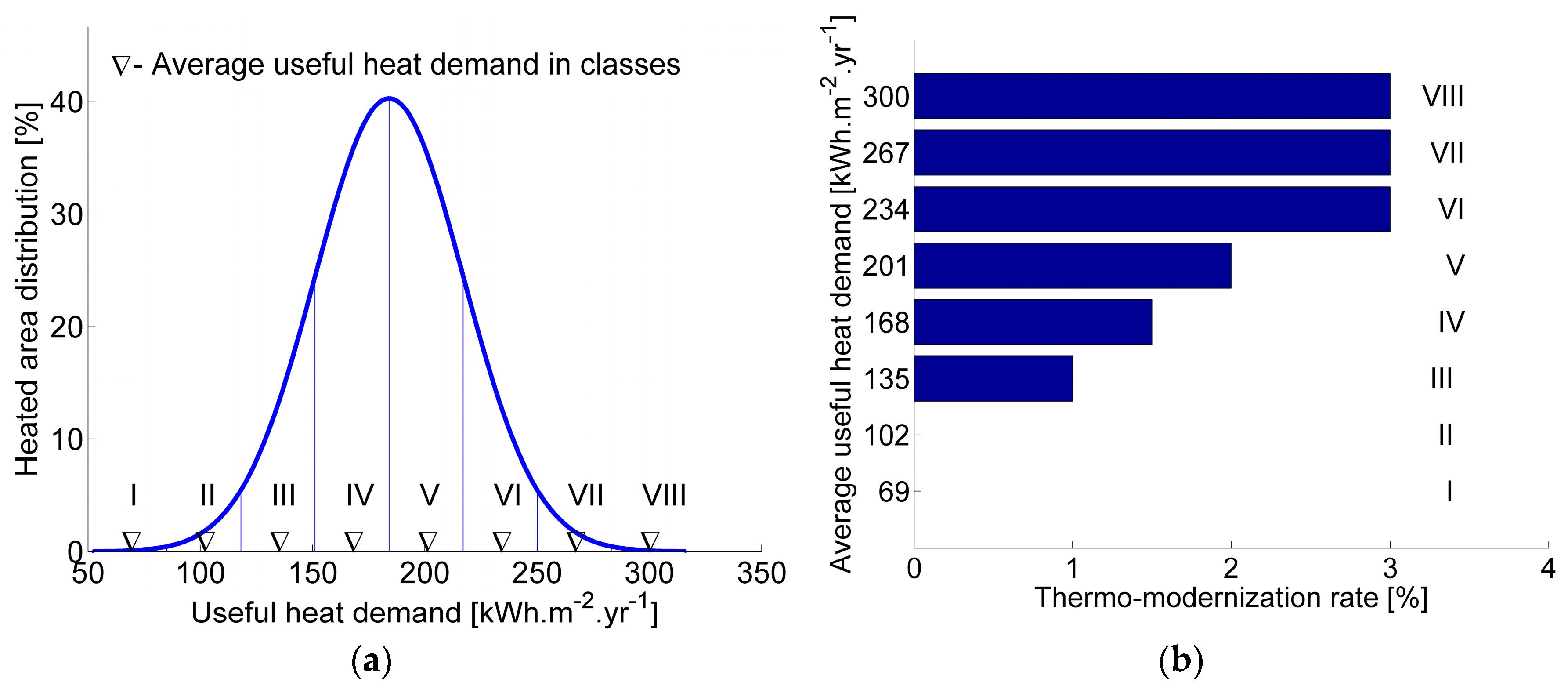

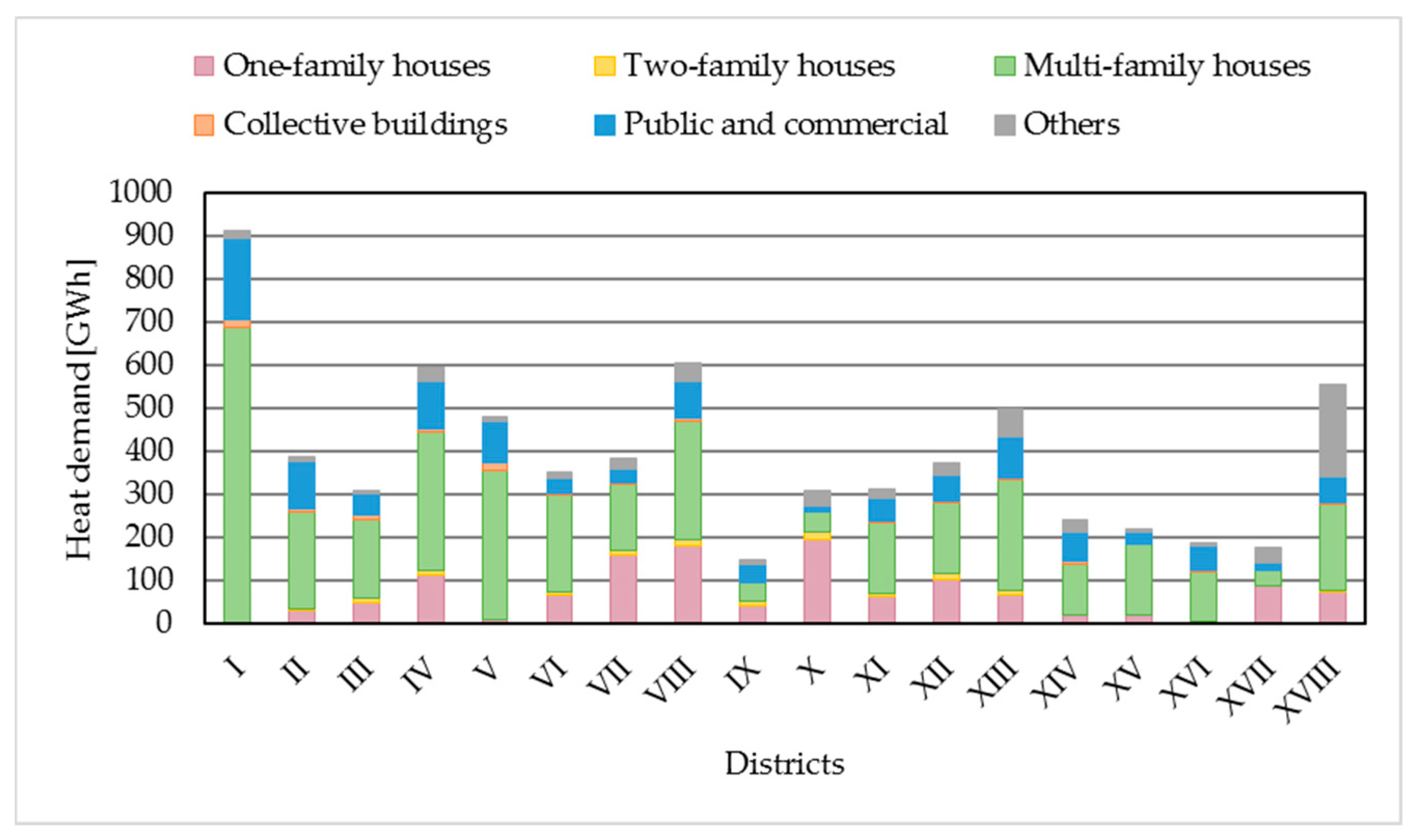
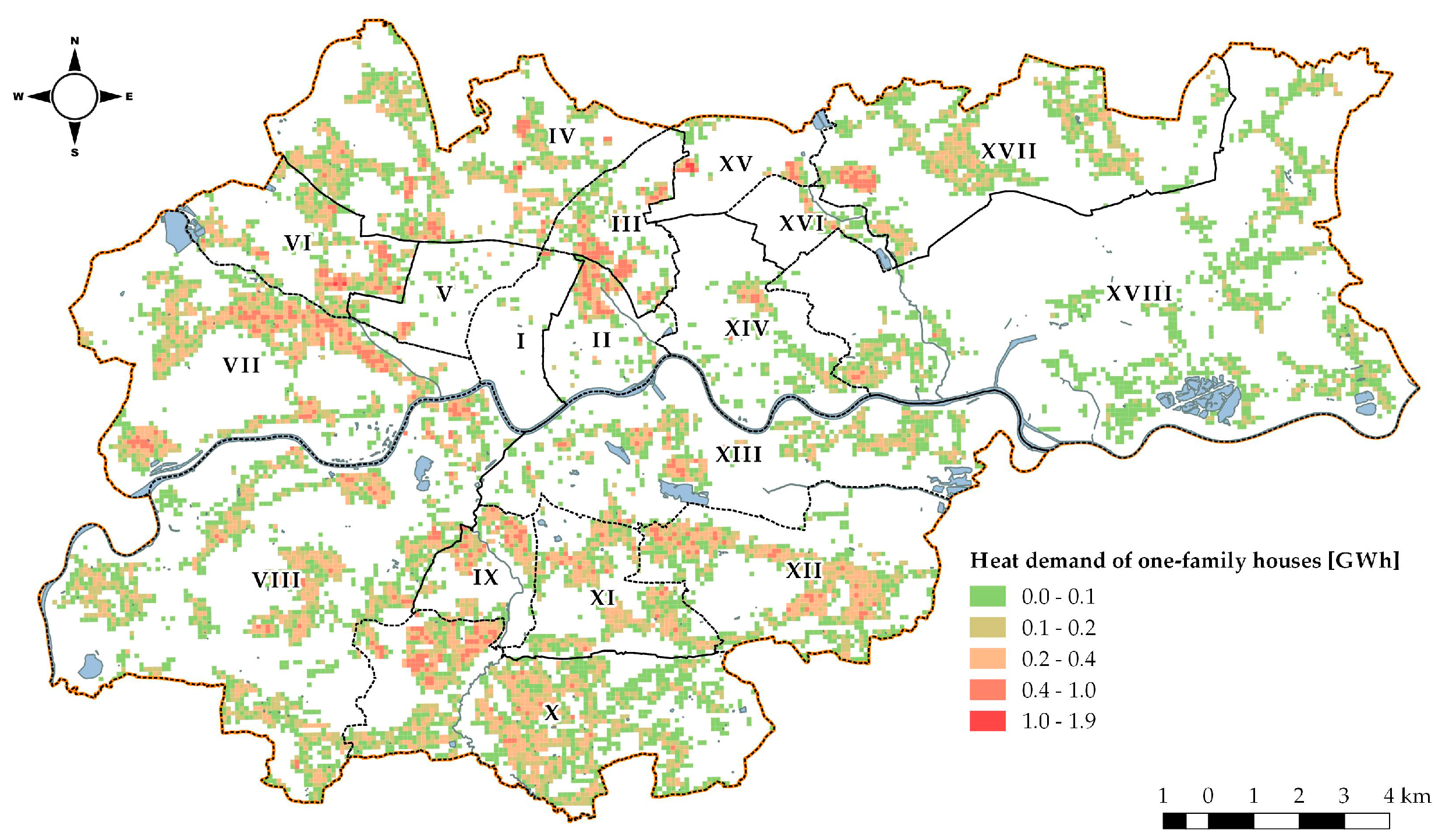
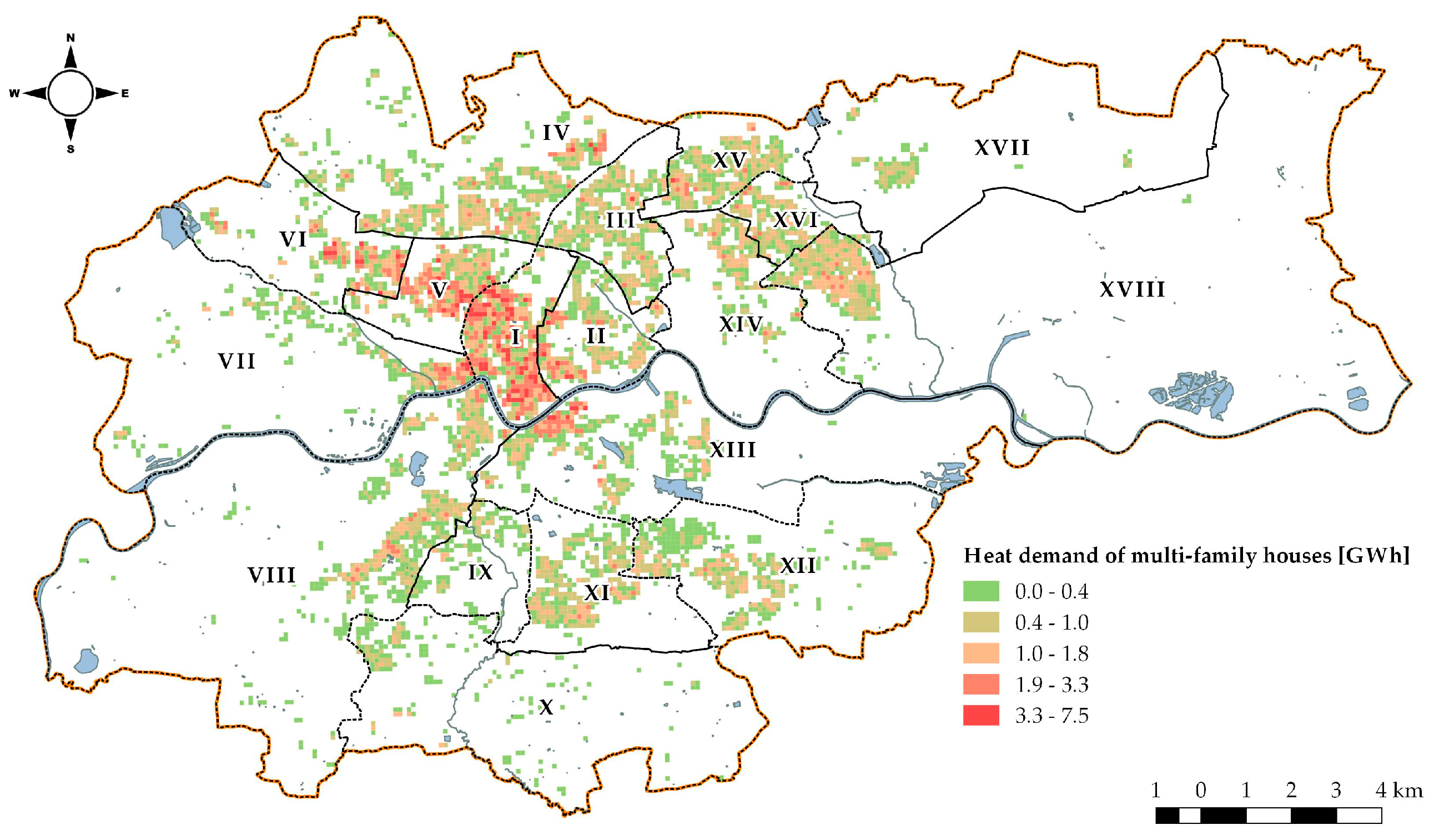
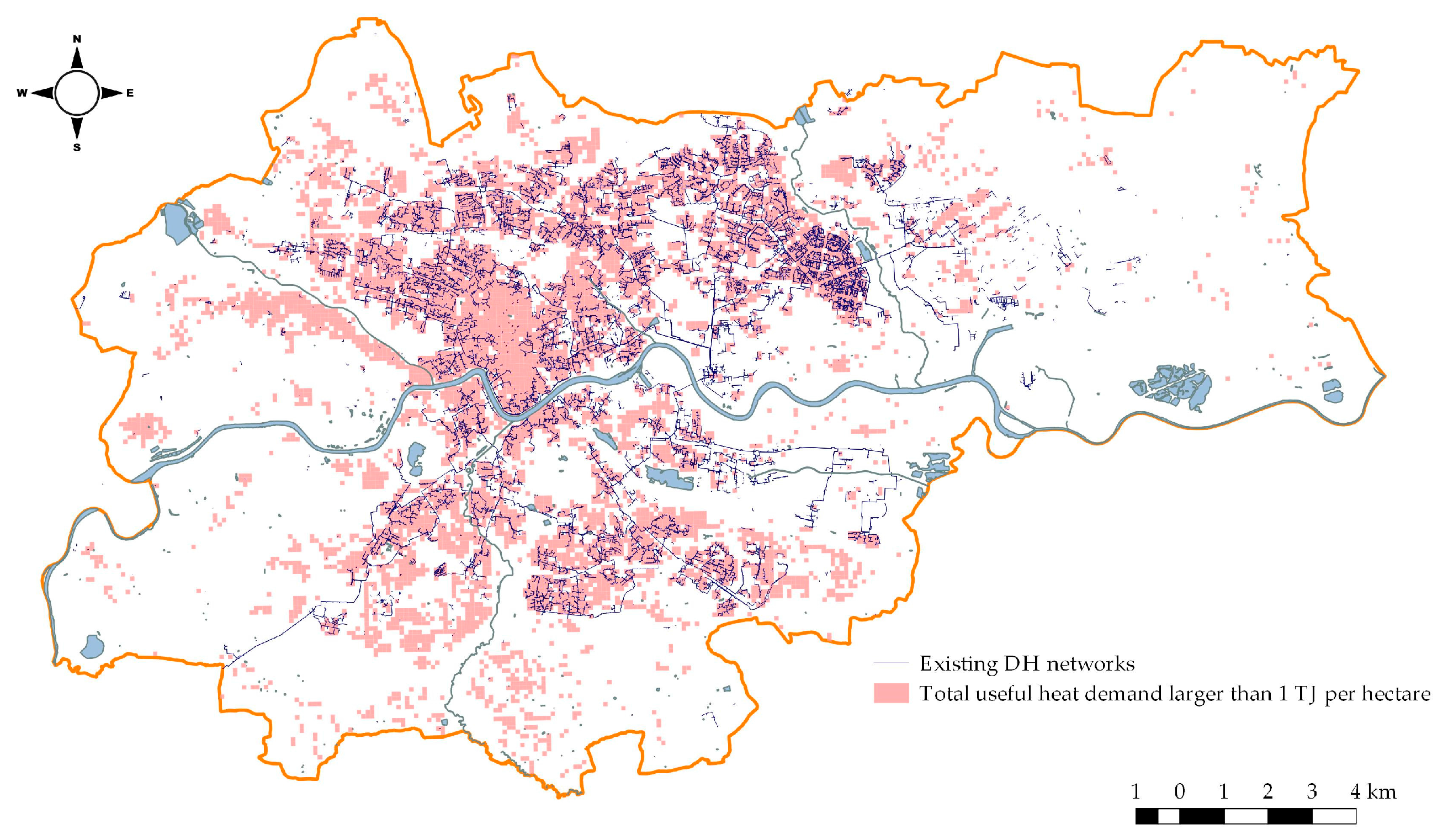
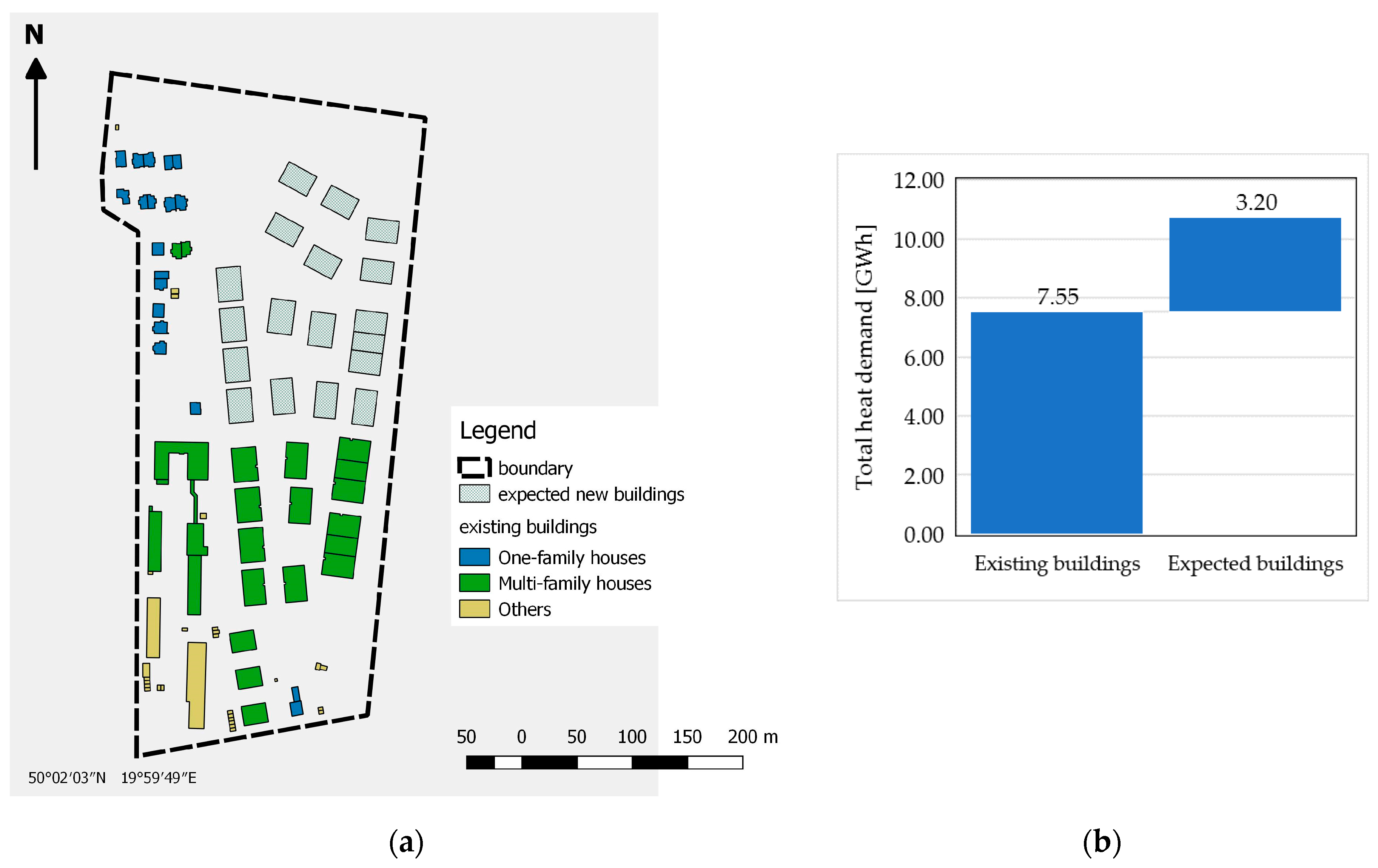
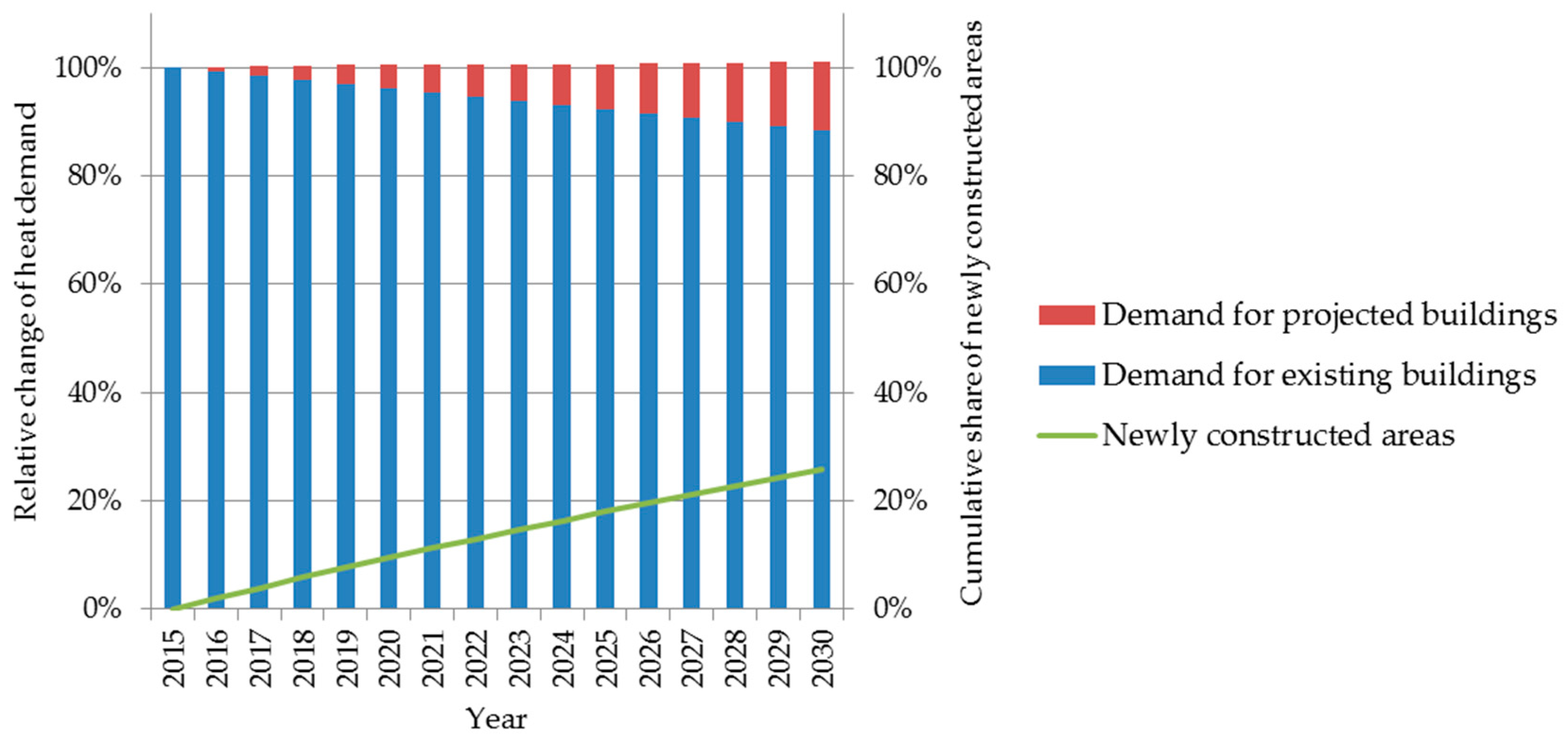
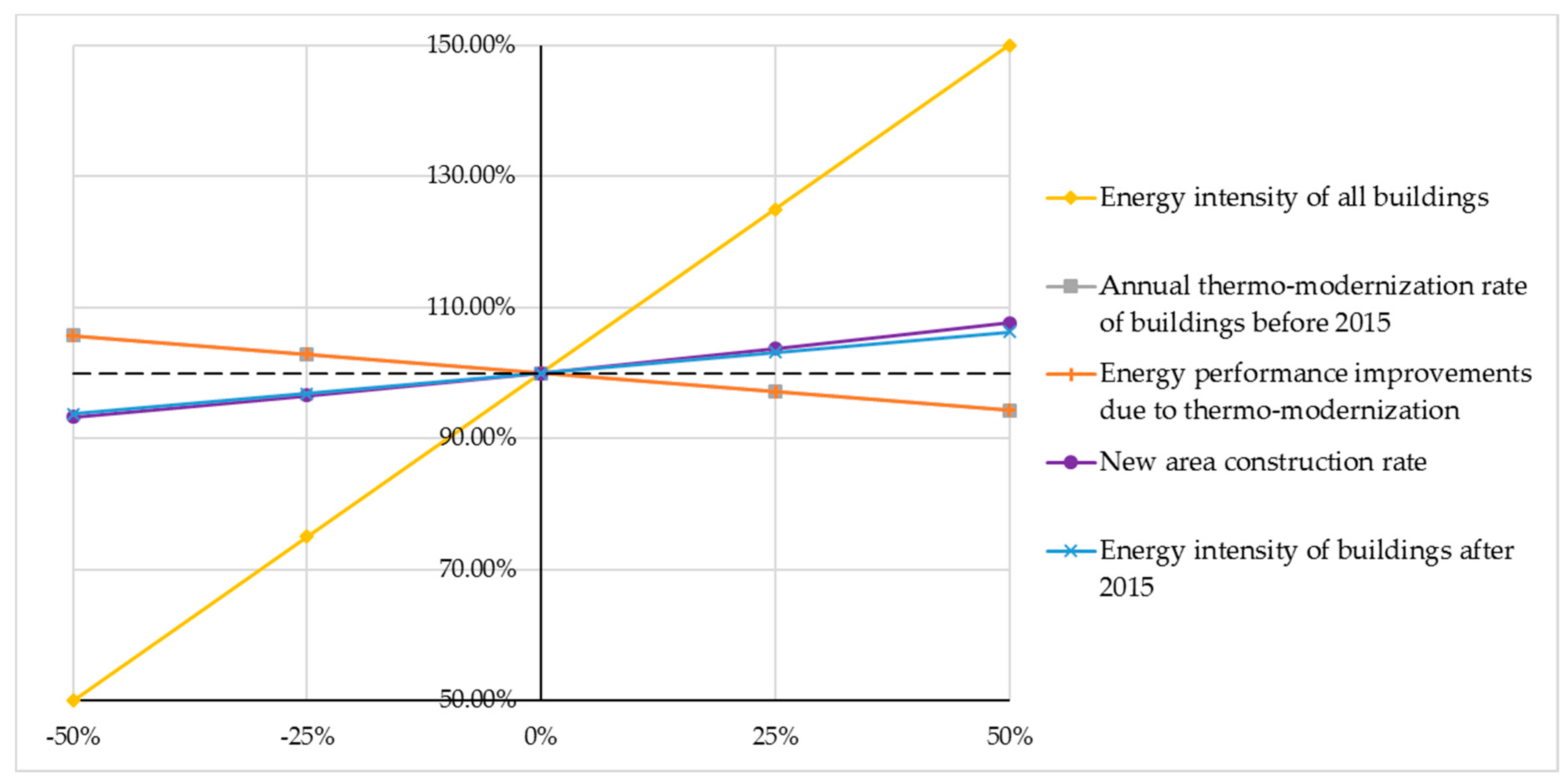
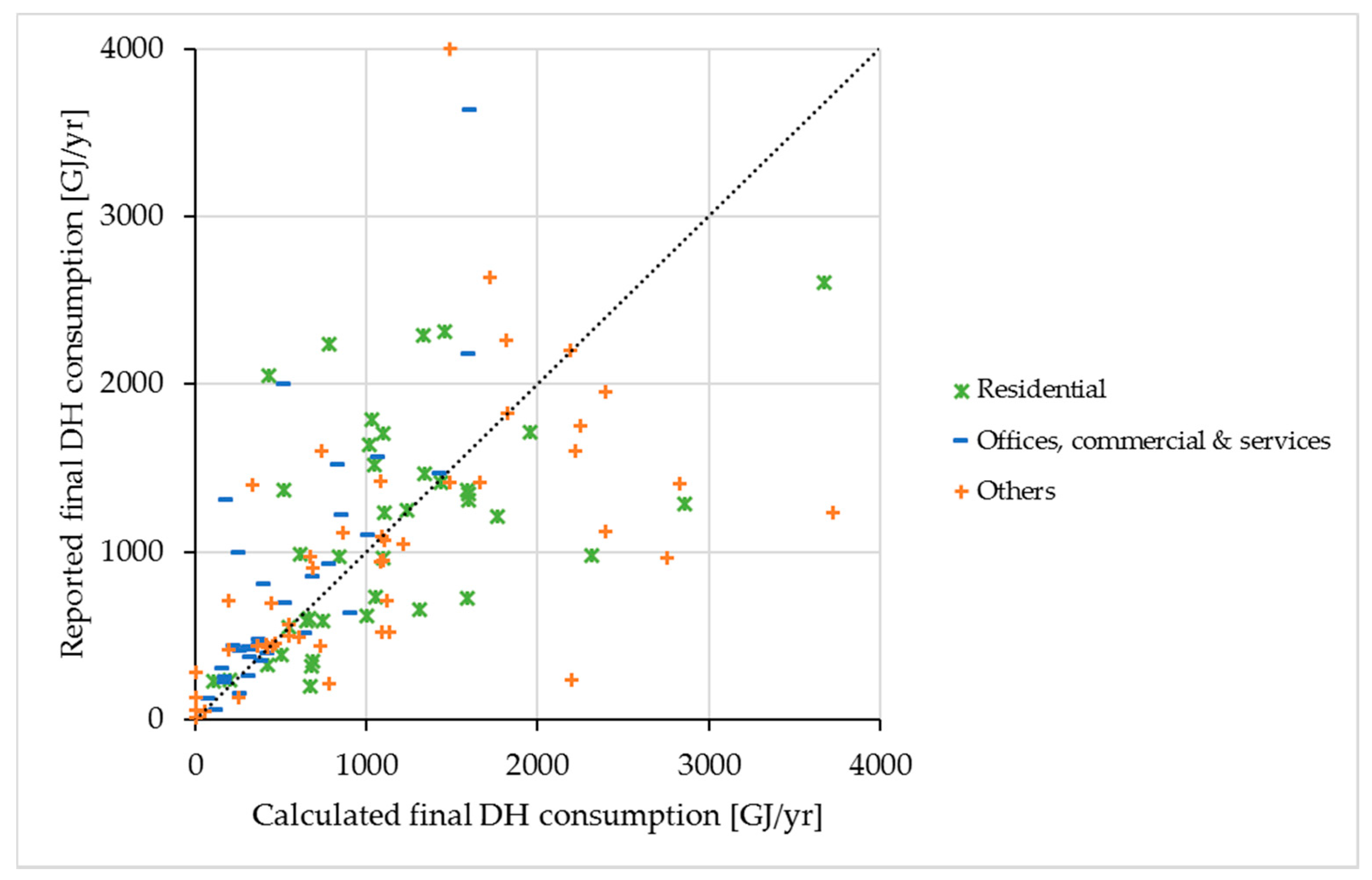
| Building Type (Code) | cf [-] | Specific Heat Demand [kWh/(m2⋅year)] | |||
|---|---|---|---|---|---|
| Non-specified area | Residential blocks since the mid-60s | Post-war multi-family buildings | |||
| One-family houses (BUBD01) | 0.79 | eh 1 | 184.1 | - | - |
| eve | 57.07 | - | - | ||
| ew | 24.09 | - | |||
| Two-family houses (BUBD02) | 0.76 | eh 1 | 162.15 | - | - |
| eve | 62.38 | - | - | ||
| ew | 27.53 | - | - | ||
| Multi-family houses (BUBD03) | 0.79 | eh 1 | 274.15 | 104.15 | 154.25 |
| eve | 41.22 | 38.74 | 39.02 | ||
| ew | 27.53 | 27.53 | 27.53 | ||
| Collective buildings (BUBD04) | 0.80 | eh 1 | 88.45 | - | - |
| eve | 44.52 | - | - | ||
| ew | 43.01 | - | - | ||
| Heating System Type | Efficiency of the Source | Efficiencies of Transmission, Regulation and Accumulation Process | Overall Efficiency |
|---|---|---|---|
| Coal boiler | 0.82 | 0.84 | 0.69 |
| Gas boiler | 0.95 | 0.84 | 0.80 |
| Oil boiler | 0.95 | 0.84 | 0.80 |
| Biomass boiler | 0.70 | 0.84 | 0.59 |
| Electric heating | 0.99 | 0.90 | 0.89 |
| District heating | 0.98 | 0.84 | 0.82 |
| Energy Carriers | 2008 | 2009 | 2010 | 2011 | 2012 | |||||
|---|---|---|---|---|---|---|---|---|---|---|
| District heat | 2611.1 | (36.6%) | 2545.8 | (35.9%) | 2565 | (34.9%) | 2571.9 | (36.3%) | 2600.0 | (36.1%) |
| Solid fuels | 399 | (5.6%) | 357.75 | (5.0%) | 316.5 | (4.3%) | 275.25 | (3.9%) | 234.0 | (3.2%) |
| Oil | 21 | (0.3%) | 22.75 | (0.3%) | 24.5 | (0.3%) | 26.25 | (0.4%) | 28.0 | (0.4%) |
| Natural gas | 1755.6 | (24.6%) | 1826.5 | (25.8%) | 1945.3 | (26.4%) | 1707.3 | (24.1%) | 1783.0 | (24.7%) |
| Electricity | 2351.4 | (32.9%) | 2335.2 | (32.9%) | 2507.1 | (34.1%) | 2510.7 | (35.4%) | 2564.0 | (35.6%) |
| Services | Useful Heat Demand | Final Energy Consumption | Final Energy Consumption Reported by MPEC 1 |
|---|---|---|---|
| Space heating | 8956 | 10,922 | 7945 |
| Building Function Types | MPE | R | FAC2 | NMSE |
|---|---|---|---|---|
| All buildings | 22.96 | 0.56 | 0.98 | 0.73 |
| Residential buildings 1 | 16.04 | 0.68 | 1.00 | 0.34 |
| Offices, commercial & services buildings 1 | −19.44 | 0.80 | 1.00 | 0.69 |
| Others | 20.61 | 0.58 | 0.98 | 0.71 |
© 2017 by the authors. Licensee MDPI, Basel, Switzerland. This article is an open access article distributed under the terms and conditions of the Creative Commons Attribution (CC BY) license (http://creativecommons.org/licenses/by/4.0/).
Share and Cite
Wyrwa, A.; Chen, Y.-k. Mapping Urban Heat Demand with the Use of GIS-Based Tools. Energies 2017, 10, 720. https://doi.org/10.3390/en10050720
Wyrwa A, Chen Y-k. Mapping Urban Heat Demand with the Use of GIS-Based Tools. Energies. 2017; 10(5):720. https://doi.org/10.3390/en10050720
Chicago/Turabian StyleWyrwa, Artur, and Yi-kuang Chen. 2017. "Mapping Urban Heat Demand with the Use of GIS-Based Tools" Energies 10, no. 5: 720. https://doi.org/10.3390/en10050720
APA StyleWyrwa, A., & Chen, Y.-k. (2017). Mapping Urban Heat Demand with the Use of GIS-Based Tools. Energies, 10(5), 720. https://doi.org/10.3390/en10050720





